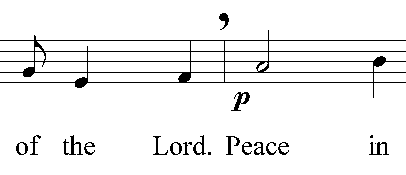- As a general rule, when singing vocal music you should only take a breath:
- Where there is a rest;
- Where there is a comma, full stop, etc. in the words;
- At the end of a phrase mark (a long slur, a curved line);
- Where there is a breath mark, usually a large comma above the stave:

- Wherever else is necessary to prevent you from passing out!
- However, none of these should interrupt the speed and flow of the music, although a breath mark can sometimes indicate a very brief pause, as in the example above.
- A pause mark (properly called a "Fermata", and sometimes referred to as a "fisheye" I am told) indicates either:
- if it is above or below a note (see example below), then that note should be lengthened to perhaps two or three times its written length;
- if it is above or below a barline, then a pause should be made at this point.




